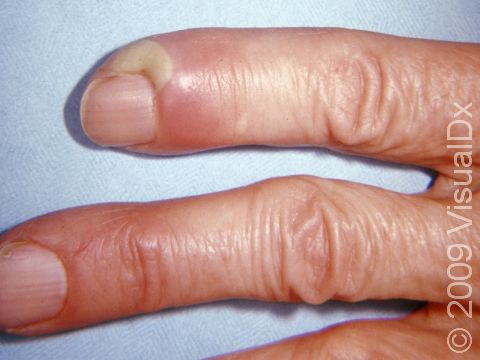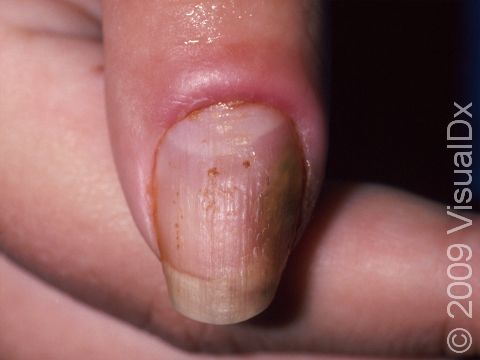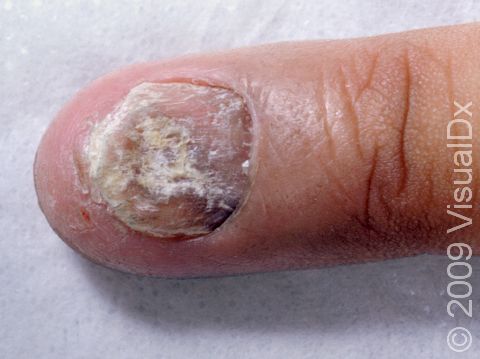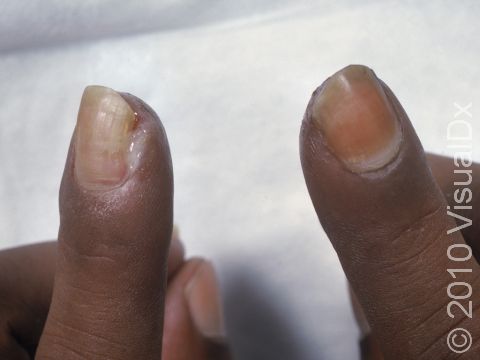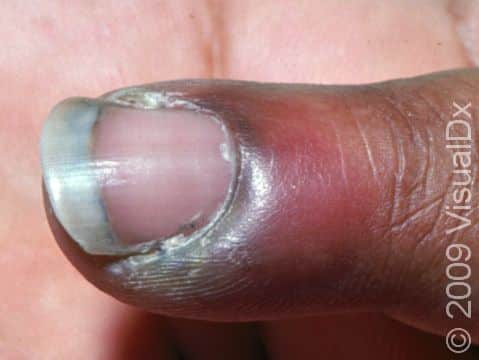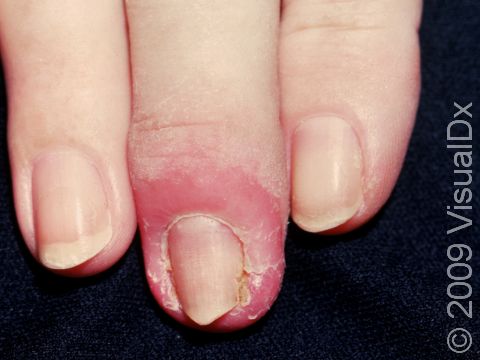Nail Infection, Bacterial (Paronychia)
Paronychia, commonly known as bacterial nail infection, is inflammation of the region of the finger or toe from which the nail plate originates, which is called the proximal nail fold (PNF). This inflammation may occur in the short term (acute) or may be a long-term problem or one that keeps coming back (chronic).
Acute paronychia develops along a break in the skin and is usually seen at the side of the nail. This type of nail infection is often caused by a bacterial infection but may also be caused by herpes, a type of viral infection.
Chronic paronychia occurs most often in people whose hands are constantly or often exposed to moisture. This disorder often results from contact dermatitis, a type of skin inflammation caused by exposure to chemicals that are irritating to the skin. People with chronic paronychia may have periodic, painful flare-ups. This type of nail infection may be complicated by the addition of a fungal infection, commonly due to a type of yeast called Candida, or bacterial infection, and this may lead to abnormal nail growth.
Who's At Risk?
Acute paronychia may occur at any age but is particularly common in children. Viral paronychia occurs more often in adults and may be seen with genital herpes infection or in people who work in the health care industry.
Chronic paronychia is most common in adult women and those who work in places where their hands are kept moist, such as food handlers.
Signs & Symptoms
Bacterial nail infection most often affects the proximal nail fold of the fingers and less commonly affects the toes.
- Acute: The proximal nail fold is red, swollen, painful, and may contain pus. Usually one nail is affected.
- Chronic: The proximal nail fold is swollen, red, and has no cuticle (the strip of hardened skin at the base and sides of a fingernail or toenail). One or more nails may be affected.
Self-Care Guidelines
- Try soaking the nails in warm water for acute paronychia.
- Avoid water and chemical exposure to prevent symptoms of chronic paronychia.
Treatments
For acute paronychia, your doctor may:
- Puncture and drain the affected area and test for bacteria or viral infection.
- Prescribe antibiotics for a bacterial infection or an antiviral medication for a herpes infection.
For chronic paronychia, your doctor may:
- Prescribe a topical steroid.
- Prescribe a topical antifungal medication.
- Prescribe topical or oral antibiotics.
Visit Urgency
See your doctor for an evaluation if you notice signs of bacterial nail infection.
Trusted Links
References
Bolognia, Jean L., ed. Dermatology, pp.263-264, 1072. New York: Mosby, 2003.
Freedberg, Irwin M., ed. Fitzpatrick’s Dermatology in General Medicine. 6th ed. pp.660, 2590. New York: McGraw-Hill, 2003.
Last modified on October 10th, 2022 at 7:17 pm

Not sure what to look for?
Try our new Rash and Skin Condition Finder
